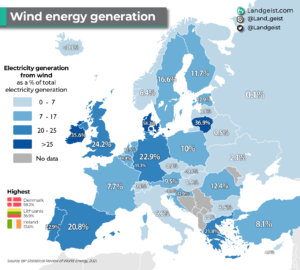By the end of 2024, wind turbines supplied 20% of Europe’s electricity (with the EU at 19%). The EU plans to increase this to 34% by 2030 and over 50% by 2050. Right now, Denmark leads the way, with wind turbines generating 58.2% of its electricity.

To reach these goals, Europe needs to add 30 GW of wind power every year. But in 2024, only 13 GW was installed (11.4 GW onshore, 1.4 GW offshore). Why is progress so slow? Here are three key reasons.
1. Slow Government Action
- Many governments have not yet adopted the EU’s new rules to speed up permits for cs.
- Without faster approvals, new projects can’t move forward.
- In some countries, the situation even got worse in 2024.
- Germany is an exception:
- It accepted the EU’s permitting rules and set strict deadlines.
- As a result, Germany approved 15 GW of new onshore wind power—seven times more than five years ago.
- If other countries follow Germany’s lead, you will see faster growth in wind energy across Europe.
2. Grid Connection Problems
- The biggest challenge now is connecting wind turbines to the power grid.
- Right now, 500 GW of wind power is stuck waiting for grid access.
- The issue isn’t just delays—the grid is not expanding fast enough to handle more power.
- A good example is Germany’s 900 MW Borkum Riffgrund 3 offshore wind farm. The wind turbines are ready, but they won’t connect to the grid until 2026.
- Unless governments act fast, many new wind turbines will be built but unable to supply power.
3. Slow Electrification
- Wind energy depends on how quickly Europe switches to electricity.
- Right now, electricity is only 23% of Europe’s total energy use.
- By 2050, this needs to reach 61% to meet climate targets.
- But industries like transportation, heating, and manufacturing are not switching to electricity fast enough.
- If electrification speeds up, demand for wind turbines will grow even more.
Positive Signs and Investment Trends
- The good news: Governments approved 37 GW of new wind capacity in 2024 (29 GW in the EU).
- But without faster permits, better grids, and more electrification, these approvals won’t lead to real change.
- Investments in wind power:
- €31 billion was invested in wind turbines in 2024, funding 19 GW of new projects.
- Onshore wind power grew, with €24 billion in investments.
- Offshore wind saw fewer investments due to slow permitting and grid delays.
What Needs to Happen Next?
WindEurope CEO Giles Dickson said:
“The EU must fix these three problems now. More wind energy means cheaper, more competitive electricity.”

